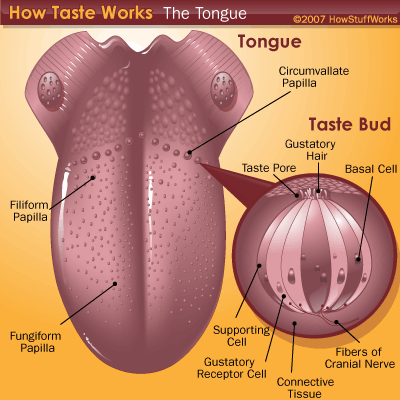Taste receptors are named taste buds and are grouped on papillae of various shapes on the tongue, mouth roof, pharynx and esophagus. The papillae give a velvet touch to the tongue. Each bud contains over 100 cells and all buds react to the basic tastes, forming a signal that is transmitted to the brain. A bud can activate several neurons and a neuron can receive signals from several buds. Each papilla contains about 100-200 buds. The sensitive taste cells have cilia.

Taste buds probably play the most important part in helping you enjoy the many flavors of food. Your taste buds can recognize four basic kinds of tastes: sweet, salty, sour, and bitter. The salty/sweet taste buds are located near the front of your tongue; the sour taste buds line the sides of your tongue; and the bitter taste buds are found at the very back of your tongue.
We have almost 10,000 taste buds inside our mouths; even on the roofs of our mouths. The number of buds varies from person to person.. Some persons have maximum 500 buds. More buds means the individual perceives more types of taste. Taste becomes ‘weaker’ with the age.
Structure of taste buds
Each taste bud is flask-like in shape, its broad base resting on the corium, and its neck opening, the gustatory pore, between the cells of the epithelium.
The bud is formed by two kinds of cells: supporting cells and gustatory cells.
The average life of a taste bud is 10 days.




One thought on “TASTE BUDS”
thank you